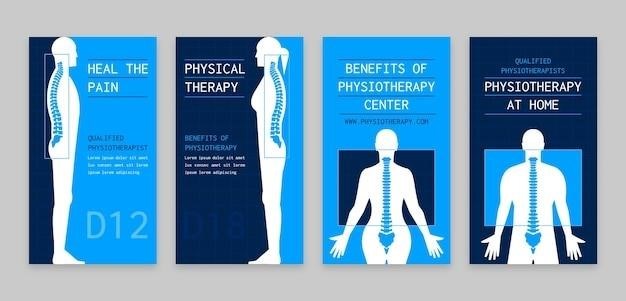Spondylolisthesis Exercises⁚ A Comprehensive Guide
This guide offers a structured approach to exercises for spondylolisthesis, drawing from various online resources and research. It emphasizes the importance of consulting healthcare professionals for personalized plans. PDF resources are mentioned for further detailed information and exercise programs.
Understanding Spondylolisthesis and Exercise
Spondylolisthesis, a condition where one vertebra slips forward over another, often in the lower back, can cause significant pain and disability. The severity varies greatly, influencing the type and intensity of exercise appropriate for each individual. Exercise plays a crucial role in managing spondylolisthesis, aiming to strengthen supporting muscles, improve spinal stability, and alleviate pain. However, not all exercises are beneficial; some may exacerbate the condition. Therefore, a tailored exercise program, guided by a physical therapist or other qualified healthcare professional, is essential. This program should consider the specific type and severity of spondylolisthesis, the patient’s overall health, and their pain levels. The goal is to gradually increase strength and flexibility, improving functional capacity and quality of life while minimizing the risk of further injury or pain. Improper exercise can worsen the slippage, increasing pain and potentially necessitating surgery. Therefore, seeking professional guidance is paramount before starting any exercise regime. Many online resources, including PDFs, provide information on suitable exercises, but they should be used as supplementary materials, not as a replacement for professional consultation. Remember that individual needs vary significantly.
Types of Exercises for Spondylolisthesis
Several exercise types address spondylolisthesis, each targeting specific aspects of recovery. Low-impact exercises, such as walking and water aerobics, are often recommended to improve mobility and circulation without excessive strain on the spine. Core strengthening exercises are crucial, focusing on the abdominal and back muscles to provide spinal support and stability. These exercises may include pelvic tilts, planks, and bridges. Specific exercises to avoid are those that involve hyperextension or excessive loading on the lower back. Back extension exercises are a contentious area, with some advocating their use under specific circumstances and professional guidance while others advise against them altogether due to the risk of further spinal displacement. The choice of exercises depends heavily on the individual’s condition, including the severity of the spondylolisthesis and the presence of any associated pain or neurological symptoms. A comprehensive rehabilitation program, often detailed in PDF resources, usually progresses through different phases, starting with gentle exercises and gradually increasing intensity and complexity as the patient improves. Always consult a physical therapist or healthcare professional to determine the most suitable exercises for your specific situation and to ensure safe and effective implementation. Ignoring professional advice may lead to injury.
Low-Impact Exercises for Pain Management
Managing pain associated with spondylolisthesis often involves incorporating low-impact exercises into a treatment plan. These exercises aim to improve mobility and circulation without putting undue stress on the spine, thereby reducing pain and inflammation. Examples of effective low-impact exercises include walking, swimming, and water aerobics. These activities provide gentle movement and support from the water, minimizing strain on the lower back. Cycling, using a stationary bike, is another excellent option, allowing for controlled exercise with minimal impact. Yoga and Pilates, practiced with proper form and modifications as needed, can also be beneficial. These disciplines focus on core strengthening and improving flexibility, which can help alleviate pain and improve spinal stability. It is crucial to start slowly and gradually increase the duration and intensity of low-impact exercises to avoid exacerbating pain. Listen to your body and stop if you experience any discomfort. Consult a physical therapist or healthcare professional for personalized guidance on choosing and performing low-impact exercises safely and effectively. Many PDF resources offer detailed exercise programs tailored to managing spondylolisthesis pain, providing visual demonstrations and modifications for different fitness levels.
Core Strengthening Exercises
Strengthening the core muscles is a cornerstone of spondylolisthesis management, as these muscles provide crucial support to the spine. A strong core helps stabilize the vertebrae, reducing stress on the affected area and minimizing the risk of further slippage. Numerous exercises target the core muscles, including the abdominal muscles (rectus abdominis, obliques, and transverse abdominis) and the back muscles (erector spinae and multifidus). Effective core strengthening exercises often involve isometric contractions, such as pelvic tilts and planks, which engage the muscles without significant movement. Progressive exercises like bridges, bird-dog, and dead bugs gradually increase the challenge and build strength. These exercises often involve controlled movements and focus on proper form to maximize effectiveness and prevent injury; Many online resources and PDF guides provide detailed instructions and visual aids for performing these exercises correctly. Remember to consult a healthcare professional or physical therapist to create a tailored core strengthening program appropriate for your individual needs and condition. A gradual progression is key to avoid overexertion and potential setbacks. The goal is to build a strong and stable core that supports the spine effectively, minimizing pain and improving overall functionality. Regular practice and consistent effort are essential for achieving optimal results.
Back Extension Exercises⁚ A Controversial Topic
The role of back extension exercises in spondylolisthesis rehabilitation remains a subject of debate among healthcare professionals. While some advocate for carefully controlled back extensions to strengthen posterior spinal muscles, others express concerns about potentially exacerbating the slippage. The controversy stems from the inherent risk of increasing shear forces on the already unstable vertebrae. The potential benefits of improved spinal stability and posture through strengthening these muscles must be carefully weighed against the risk of further displacement. The key lies in the execution and progression of these exercises. Aggressive or improperly performed back extensions can be detrimental. Therefore, the decision to include back extensions in a treatment plan should be made on a case-by-case basis, considering the severity of the spondylolisthesis, the individual’s physical condition, and the guidance of a qualified healthcare provider. Many online resources and PDF guides offer various approaches, but personalized guidance is crucial. A physical therapist can assess the patient’s specific needs and design a safe and effective program that minimizes risks and maximizes therapeutic gains. Focus should be on controlled movements, proper form, and gradual progression to avoid injury. Always prioritize safety and listen to your body; discontinue any exercise causing pain or discomfort.
Rehabilitation Programs and Phases
Effective spondylolisthesis rehabilitation typically involves a phased approach, progressing from conservative management to more advanced exercises as the patient’s condition improves. Initial phases often focus on pain management and reducing inflammation through rest, ice, and gentle range-of-motion exercises. As pain subsides, the program incorporates core strengthening exercises to improve spinal stability and reduce the load on the affected vertebrae. Several online resources and PDF guides detail these phases. A typical progression might start with simple pelvic tilts and progress to more challenging exercises like planks and bridges. Later phases may involve low-impact cardiovascular activities to improve overall fitness and flexibility. The duration of each phase is highly individualized and depends on the patient’s response to treatment and the severity of their condition. Regular monitoring by healthcare professionals, including physical therapists, is essential to ensure safe and effective progression through the rehabilitation phases. Many PDF resources provide detailed exercise progressions and modification strategies for different phases of recovery. It’s crucial to adhere to the prescribed program and communicate any concerns or setbacks to your healthcare team. Remember, consistency and adherence to the rehabilitation plan are key to achieving optimal outcomes.

Exercises to Avoid
Understanding which exercises to avoid with spondylolisthesis is crucial for preventing further injury and pain exacerbation. High-impact activities that place significant stress on the lumbar spine should be avoided. These include activities like heavy weightlifting, especially those involving flexion or extension movements. Certain exercises that involve repetitive or forceful twisting or bending motions are also detrimental. Jumping, running, and other high-impact activities are generally discouraged in the early stages of recovery. Additionally, exercises that cause significant pain or discomfort should be stopped immediately. Avoid exercises that put excessive strain on the lower back muscles, potentially worsening the slippage of the vertebrae. The specific exercises to avoid can vary depending on the severity of the spondylolisthesis and the individual’s response to treatment. It’s crucial to work closely with a physical therapist or healthcare professional to develop a safe and effective exercise program that accounts for individual needs and limitations. Many online resources and PDF guides offer detailed information on exercises to avoid, emphasizing the importance of individualized exercise plans tailored to the patient’s specific condition and needs.

PDF Resources for Spondylolisthesis Exercises
Numerous PDF resources are available online offering comprehensive guides to spondylolisthesis exercises. These resources often provide detailed exercise programs tailored to different stages of recovery, from initial rest and pain management to advanced strengthening and return-to-activity phases. Some PDFs focus on specific exercise techniques, such as core strengthening or low-impact exercises, while others offer broader rehabilitation programs encompassing various treatment modalities. These documents may include illustrations or videos demonstrating proper exercise form, ensuring safe and effective execution. Many PDFs emphasize the importance of consulting with a healthcare professional before starting any exercise program. The information presented in these resources should be considered supplementary to, not a replacement for, professional medical advice. It’s essential to verify the credibility and authority of the source before relying on the information contained within a PDF. Reputable sources may include those from established medical institutions, physical therapy clinics, or qualified healthcare professionals. Always remember that individual needs vary, and a personalized approach is crucial for successful treatment and rehabilitation.
The Role of Physical Therapy
Physical therapy plays a pivotal role in managing spondylolisthesis, often forming the cornerstone of non-surgical treatment. A physical therapist conducts a thorough evaluation to assess the individual’s condition, identifying specific limitations and areas needing improvement. Based on this assessment, a customized exercise program is developed, focusing on strengthening weakened muscles, improving flexibility, and enhancing core stability. This program may incorporate various techniques, including manual therapy, to address muscle imbalances and joint restrictions. The therapist guides patients through proper exercise form, ensuring safety and effectiveness. Regular monitoring and adjustments are crucial to optimize the program’s effectiveness and address any emerging issues. Beyond exercise, physical therapists educate patients on proper body mechanics, posture, and activity modification strategies to minimize stress on the spine. They may also employ other therapeutic modalities, such as heat or ice, to manage pain and inflammation. The collaboration between patient and physical therapist is essential for successful rehabilitation. Consistent adherence to the prescribed exercises and lifestyle modifications is crucial for optimal outcomes and long-term management of spondylolisthesis.
Leave a Reply
You must be logged in to post a comment.